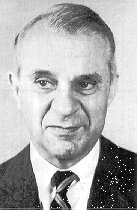| Profile | Major Works | Resources |
Wassily Leontief, 1906-1999


Wassily Leontief's name has been associated with a particular type of
quantitative economics: input-output analysis.
A general equilibrium method of analysis, input-output models examine economic
activity by studying the relationships between sectors. Although of fluctuating
popularity, input-output analysis has been a mainstay of economics and economic policy and
planning since Leontief introduced it in the 1940s.
Wassily Leontief was born into a well-to-do academic family in St. Petersburg, Russia. His father was a labor economist at the local university, his mother an art historian. Wassily Leontief enrolled at the University of Leningrad in 1921, at the tender age of fifteen. He started out in philosophy, but eventually moved on to economics, earning his MA in 1925. Finding times in Communist Russia difficult, his parents emigrated to Germany, bringing Leontief along with them. Leontief enrolled for graduate studies at the University of Berlin, obtaining his Ph.D in 1928 under Ladislaus von Bortkiewicz and Werner Sombart.
Leontief joined the Kiel Institute in 1927, where the seeds of his input-output analysis were laid. Input-output was partly inspired by the Marxian and Walrasian analysis of general equilibrium via inter-industry flows - which in turn has ancestral origins in Quesnay's Tableau Economique. Leontief's interest was an outgrowth of the "multi-sectoral" approach to business cycles being followed by the Kiel School.
In 1929-30, Leontief interrupted his research to spend a year in China as an economic consultant to the Chinese State railways. Wassily Leontief moved to the United States in 1931, as a researcher at the NBER, intending to continue his research program into multi-sectoral economic systems. A year later, Wassily Leontief took up a position at Harvard University in 1932. Leontief joined Joseph Schumpeter in presiding over the "golden generation" of Harvard economics in 1930s. However, it took some time to set in. It was only after three years that Leontief was finally allowed to teach his specialty. Leontief's "Price Analysis" seminar, launched in the Fall of 1935, would be the incubator of mathematical economics at Harvard. Leontief's work at this time was largely in the vein of the Paretian revival, to which he made several seminal contributions (e.g. 1933). But Leontief was already constructing an empirical example of his input-output system - an effort which yielded his 1941 classic, Structure of American Industry. Leontief followed up this work with a series of classical papers on input-output economics (collected in 1966). Input-output was novel and inspired large-scale empirical work. It was used for economic planning throughout the world, whether in Western, Socialist or Third World countries, for the next half-century.
It was also of crucial theoretical importance. Input-output inspired the analysis of linear production systems, which were instrumental in the development of modern Neo-Walrasian theory. Unusual for most economic contributions, Leontief's system was also crucial for the revival of Classical Ricardian theory. The structure of input-output (albeit with some critical differences) was employed by Piero Sraffa and the Neo-Ricardians in the 1960s to resurrect the theories of Ricardo and Marx (although apparently neither Leontief nor Sraffa ever cited each other in their parallel work).
Leontief's contributions to economics were not limited to input-output. His 1936 article on "composite commodities" made him, together with Hicks, the father of that famous microeconomic theorem. His early reviews of Keynes's General Theory (1936, 1937, 1947, 1948) were important stepping stones to the Neo-Keynesian synthesis's stress on fixed nominal wages in interpreting Keynes's theory. Among his classic contributions are his 1933 article on the analysis of international trade via indifference curves, which is still learned today, his non-linear cobweb model (1934), and his 1946 contribution on the wage contract, which outlined what is now a classical application of the principal-agent model before that term was invented. One of his more stirring contributions has been his 1953 finding that Americans were exporting labor-intensive rather than capital- intensive goods - the "Leontief Paradox" - which brought into question the validity of the conventional factor-proportions theory of international trade.
After having presided at Harvard for forty years, Leontief moved to the C.V. Starr Center at New York University. As a critic, Leontief's repeated admonishment of economics for its misuse of mathematics and quantitative methods and the lack of relevance and realism in its theorizing (e.g. 1938, 1954, 1959, 1971) are both lucid, sharp and still pertinent. It was for his development of input-output that Wassily Leontief won the Nobel memorial prize in 1973.
|
Major Works of Wassily Leontief
|
HET
|
|
Resources on Wassily Leontief
|
All rights reserved, Gonçalo L. Fonseca
